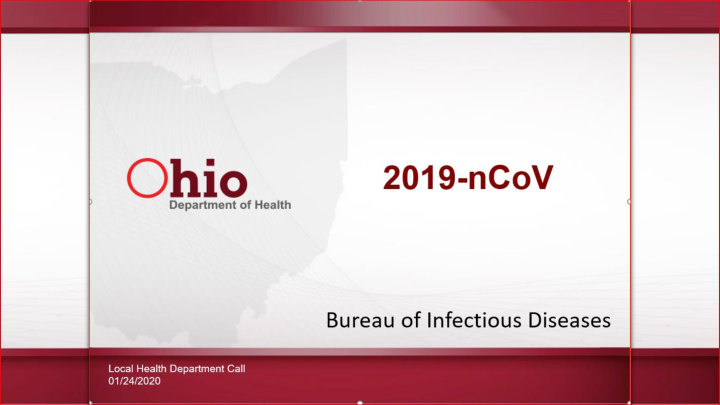



Ohio Department of Health: Public Health Response • Monitoring situation • Health alerts (HAN) • Director’s Journal Entry • Press Release • Ohio Disease Reporting System (ODRS) 2019-nCoV Module • Evaluating patients under investigation (PUI) • Creating guidance for specimen submission • Updating Ohio Infectious Disease Control Manual (IDCM)
Coronaviruses that Infect Humans • Common • 229E (alpha coronavirus) • NL63 (alpha coronavirus) • OC43 (beta coronavirus) • HKU1 (beta coronavirus) • Other • MERS-CoV (the beta coronavirus that causes Middle East Respiratory Syndrome, or MERS) • SARS-CoV (the beta coronavirus that causes severe acute respiratory syndrome, or SARS) • 2019 Novel Coronavirus (2019-nCoV)
Phylogenetic Tree of Coronavirus
Travel Recommendations
Symptoms • Patients with confirmed 2019-nCoV infection have reportedly had mild to severe respiratory illness with symptoms including • Fever • Cough • Shortness of breath • CDC believes that symptoms of 2019-nCoV may appear in as little as 2 days or as long as 14 days after exposure (based on other coronaviruses e.g. MERS and SARS)
Patient Under Investigation (PUI) Clinical Features & Epidemiological Risk Fever and symptoms of lower respiratory illness and In the last 14 days before symptom onset, a history (e.g., cough, difficulty breathing) of travel from Wuhan City, China. – or – In the last 14 days before symptom onset, close contact with a person who is under investigation for 2019-nCoV while that person was ill. Fever or symptoms of lower respiratory illness and In the last 14 days, close contact with an ill laboratory- (e.g., cough, difficulty breathing) confirmed 2019-nCoV patient.
Airport Card
Clinicians Should • Use appropriate personal protective equipment • Patients wear surgical mask • Healthcare personnel use standard, contact, droplet and airborne precautions and use eye protection (goggles or a face shield) • Exam room private, door closed; ideally airborne infection isolation room (AIIR) • Obtain detailed travel history for patients with fever and respiratory symptoms • For patients who traveled to Wuhan on or after December 1, 2019 and had onset of illness within 2 weeks of leaving, consider the novel coronavirus outbreak in China when evaluating a patient with these symptoms and notify infection control personnel and your local health department immediately.
Clinicians Should • Notify infection control personnel at their healthcare facility and contact their local health department immediately to notify them of patients with fever and lower respiratory illness who traveled to Wuhan, China within 14 days of symptom onset. • Collect clinical specimens for routine testing of respiratory pathogens at either clinical or public health labs. • Local and state public health staff will determine if the patient meets the criteria for a PUI for 2019-nCoV. • For PUIs, collect three specimen types, lower respiratory, upper respiratory and serum specimens is recommended; these specimens can be sent to the ODH Public Health Laboratory for testing at CDC.
Role of Local Health Department • Engage and ensure local healthcare facilities have received the 1/23/2020 Health Alert 2019 Novel Coronavirus (2019-nCoV) • When notified of a potential PUI by a healthcare provider, immediately notify ODH via Class A reportable disease line (24/7 ID- on-Call) • Complete the PUI form in coordination with healthcare provider • Fax the PUI Form to ODH (614) 564-2456 or send by secure email to ORBIT@odh.ohio.gov; ODH will send form to CDC • Facilitate specimen shipment to ODH Lab • ODH will facilitate specimen shipment, fax PUI form to CDC • If LHDs have general questions during business hours (614) 995-5599
Shipping Information • All Ohio specimens will go through ODH Lab to CDC, Call (614) 995-5599 to get shipping account information • Paperwork • ODH Microform • Local Lab Results • CDC 50.14 • Ship as UN 3373 Biological Substance Category B • Follow DOT IATA
Frequently Asked Questions • The HAN alert mentions that health care personnel entering the room of a patient under investigation (PUI) should use standard, contact, droplet, and airborne precautions. • Standard • Contact • Droplet • Airborne precautions • LHDs should work with infection preventionist at facilities https://www.cdc.gov/infectioncontrol/guidelines/isolation/index.html
• When notified of a potential PUI by a For More healthcare provider, immediately notify ODH Information on via Class A reportable disease line (24/7 ID- on-Call) 2019-nCoV • General Information (614) 995-5599
Recommend
More recommend